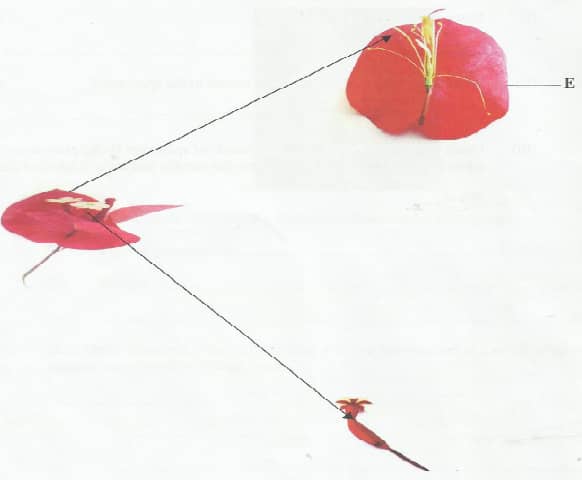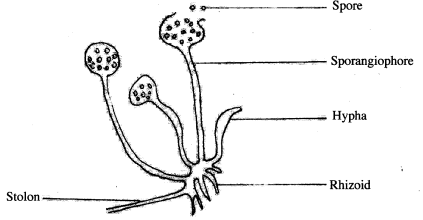- Below is a photograph showing a seedling during germination.
- With a reason, name the type of germination shown in the photograph
- Type of germination .......(1 mark)
- Reason ........................(2 marks)
- State three functions of the part labelled A in the germination of a seedling up to the appearance of the first foliage leaves. (3 marks)
- Account for the change in shape the seedling will undergo to straighten. (6 marks)
- With a reason, name the type of germination shown in the photograph
-
- You are provided with a specimen labelled D which has been grown on a substrate.
- Name the specimen (1 mark)
- What type of asexual reproduction occurs in the specimen? (1 mark)
- Using a mounting pin, pick a few strands of specimen D and place them on the white tile. Using a hand lens, observe the strands and make a labelled drawing. (3 marks)
- The photograph below shows different parts of a flower.

- Name the class of the plant from which the photograph was taken. (1 mark)
- Using observable features on the photograph, give three reasons for your answer in (b) (i) above. (3 marks)
- Name the agent of pollination for the flower in the photograph. (1 mark)
- State three observations on the photograph that support the answer in (b)(iii) above.
(3 marks) - Name the part labelled E on the photograph. (1 mark)
- You are provided with a specimen labelled D which has been grown on a substrate.
- You are provided with a potato, a 10 ml measuring cylinder, dilute hydrogen peroxide solution and substances F (pH 4), G (PH7) and H (PH 9). Cut the potato and remove a piece mcasuring 1 cm' from it. Cut thc 1 cm piece into tiny pieces and crush (macerate) them on a clean while lile using a glass rod Divide the macerated potato into three equal portions for use in the procedure that follows:
- Put 2cm3 of substance F (pH 4) into the 10 ml measuring cylinder. Add one portion of the macerated potato into the measuring cylinder Read and record the volume of the mixture in the table provided below.
Add one drop of washing-up solution.
Add 1 cm of dilute hydrogen peroxide solution to the mixture and immediately start a stop clock or watch. At the end of two minutes, read the mark to which the foam rises
Record the reading in the table provided.
Clean and rinse the measuring cylinder with distilled water. - Put 2cm3 of substance G (PH7) into the measuring cylinder.
Add the second portion of the macerated potato.
Read and record the volume of the mixture in the table.
Add one drop of washing-up solution.
Add 1 cm3 of dilute hydrogen peroxide solution to the mixture and immediately start a stop clock or watch. At the end of two minutes, read the mark to which the foam rises.
Record the reading in the table.
Clean and rinse the measuring cylinder with distilled water. - Put 2cm3 of substance H (PH9) into the measuring cylinder.
Add the third portion of the macerated potato.
Read and record the volume of the mixture in the table.
Add one drop of washing-up solution.
Add 1 cm3 of dilute hydrogen peroxide solution to the mixture and immediately start a stop clock or watch. At the end of two minutes, read the mark to which the foam rises.
Record the reading in the table.
(9 marks)F(pH 4) G (pH 7) H (PH9) Volume of solution
+
portion of potatoVolume of solution
+
portion of potato
+
foamVolume of foam - Using the data obtained in the table, calculate the volume of the foam produced in each of the pH 4, pH 7, and pH9 substances. Record the volumes in the table.
- Account for
- the observation made when hydrogen peroxide was added to the potato mixture
(3 marks) - the difference in the volume of foam produced in pH4 and pH9 substances (2marks)
- the observation made when hydrogen peroxide was added to the potato mixture
- Put 2cm3 of substance F (pH 4) into the 10 ml measuring cylinder. Add one portion of the macerated potato into the measuring cylinder Read and record the volume of the mixture in the table provided below.

MARKING SCHEME
-
-
- Epigeal germination; (1 mark)
- Hypocotyle grows faster, raising the cotyledons above the ground level; (2 marks)
-
- Protection of the embryo/plumule/plumule and radicle;
- Food storage;
- Photosynthesis;
(3 marks)
-
- Emergence of the hypocotyle exposes it to light;
- Light stimulates migration of auxins to the lower side of the hypocotyle;
- High concentration of auxins; on the lower side;
- Stimulates faster rate of growth than on the upper side;
- Faster elongation of the lower side straightens the seedlings:
(6 marks)
-
-
-
- Rhizopus/Bread mould/cassava mould/ugali mould/mould/mucor; Rhizopus spp; (1 mark)
- By spores/sporulation/sporulation; (1 mark)
-
Mg x 5 - x 25
Drawing (D)- Continuous outline
- Use of double lines
- Stolon/Rhizoid not a must
L = 5 max 2 marks
D=1
mg = 1
Max = 3 marks
-
- Dicotyledonae; (1 mark)
-
- Net/Reticulate venation/network venation:
- Floral parts in 5s/fours/five sepals/five petals;
- Broad leaf lamina/bract;
- Presence of leaf paticle;
(3 marks)
- Insects; (1 mark)
-
- Conspicuous bracts/petals/sepals/brightly coloured petals/bracts:
- Tabular corolla;
- Landing stage/corolla stage/platform;
First correct three (3 marks)
- Bract; (1 mark)
-
-
-
F(pH 4) G (pH 7) H (PH9) Volume of solution
+
portion of potato2.2±0.2; Volume of solution
+
portion of potato
+
foam4.2±0.5; Volume of foam 2.0±0.5; - Award accuracy for volume of solution + portion of potato 3 x 1 = 3 marks
- Values should be F<; G < H and solution + potato + foam is > solution + potato;
3 marks - Award correct subtraction for volume of foam 3 x 1 = 3 marks
-
- The enzyme catalase; in the potato tissue breaks down hydrogen peroxide to water, and oxygen; (3 marks)
- More foam is produced at pH 9; which is optimum for catalase activity: (2 marks)
-
Join our whatsapp group for latest updates
Tap Here to Download for 50/-
Get on WhatsApp for 50/-
Download KCSE 2012 Biology Paper 3 with Marking Scheme.
Tap Here to Download for 50/-
Get on WhatsApp for 50/-
Why download?
- ✔ To read offline at any time.
- ✔ To Print at your convenience
- ✔ Share Easily with Friends / Students



